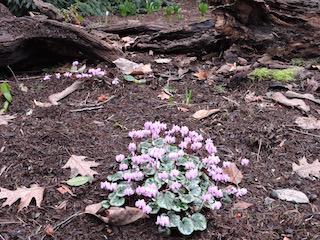Folklore in the Garden
At this time of year the garden is more twig than leaf, despite the attempts of crocus, snowdrops, hellebores, and the like, to break through winter bleakness.
 At this time of year the garden is more twig than leaf, despite the attempts of crocus, snowdrops, hellebores, and the like, to break through winter bleakness. Fortunately, it’s possible to fill in the gaps with folklore. At the very least the tales of fairies, superstitions, and beliefs associated with trees will keep you warm on a cold day.
At this time of year the garden is more twig than leaf, despite the attempts of crocus, snowdrops, hellebores, and the like, to break through winter bleakness. Fortunately, it’s possible to fill in the gaps with folklore. At the very least the tales of fairies, superstitions, and beliefs associated with trees will keep you warm on a cold day.
I am reminded of this when I wander to the great lawn past the Lavalle hawthorne (Crataegus x lavallei). The pictured trunk was once a Lavalle hawthorne that has been left to decay gracefully. Hawthornes have a long and close connection with folklore. It is believed, particularly by the Irish, that the hawthorn is a portal to the fairy underworld and so it behooves a person to treat the tree with respect. Disappear down that gateway and you are subject to fairy time. You won’t get home for dinner for at least seven years even if your stay in the underworld appears fleeting.
Another tree surrounded with stories is Fagus sylvatica, the European Beech. The specimen standing at the end of the driveway is particularly majestic and is one of the original or heritage trees of which the Dunn is proud. If, so we are led to believe, you carve your greatest wish on a fallen beech branch and poke it into the ground, a fairy will come and collect it. She will take it to the underworld for the Faery Queen to consider. Beech is an old symbol of prosperity, perhaps because the branches are favored for divining. Water equals wealth as we are learning anew in these times.
Other trees have equally splendid powers, particularly most varieties of oaks. Have a toothache? Hammer a nail into an oak to chase it off. Hernias and infertility can by cured by hugging the said tree. Stand under it if you want to ward off evil spirits, particularly if the oak is planted at a crossroad. (The Dunn has two heritage oak trees: Pin Oak or Quercus palustris and Northern Red Oak: Quercus rubra.)
Some trees, such as magnolias, flower before they leaf. A Magnolia sargentiana ‘robusta’ has been resident at the Dunn since the 1960s and the tree can bloom as early as February or as late as April. Planting a magnolia close to your bedroom, folklore tells us, assures you of a faithful partner. No wonder the symbolism of the flower is nobility.
Hawthornes, beeches, and magnolias are deciduous but evergreens are not without folklore mystery. One story is about a bird breaking his wing as he is about to fly south for winter. She begs the trees about her for protection from the frost and snow, but none of the birches, oaks and willows offer it. A spruce could not stand the bird’s distress and offers her a warm, protective branch. Some others followed his example: pine and juniper, particularly. After observing this act of kindness, the Frost King instructed the North Wind not to touch a single leaf of the trees that extended charity and to disturb those that did not. So today the North Wind blows their leaves off when winter is coming.
Some of the most majestic evergreen trees in the Dunn Gardens are the Douglas-firs. Presumably the North Wind avoids disturbing them before winter but it is the cone that is distinctive and interesting, at least in terms of folklore. Native Americans will tell you that Mouse was surprised by Fox one day when he was out looking for something to eat. The Douglas-fir encouraged the frightened creature to hide in its cone and Mouse was grateful. But he was also a bit large. When you look at a cone you can see the mouse’s tail and back legs sticking out.
Before you dirt-in-nails gardeners and Dunn supporters scoff at such nonsense I will draw your attention to a quote by a blogger whose name is Robert Brault. rbrault.blogspot.com
In every gardener there is a child who believes in The Seed Fairy.
It won’t be long before she is back to visit. Yipppeeee!

